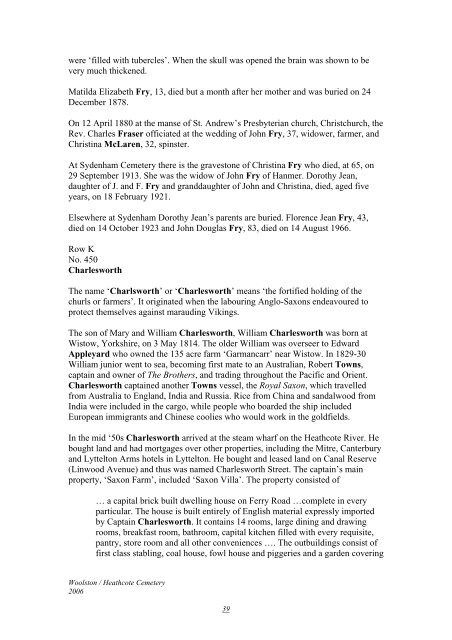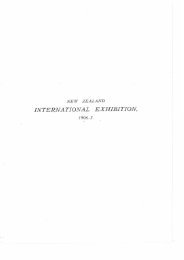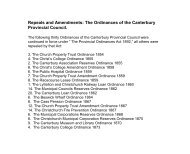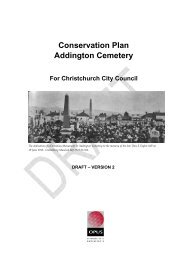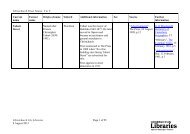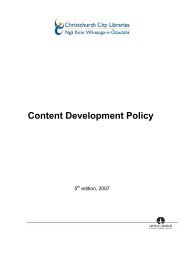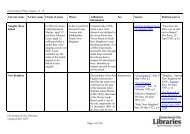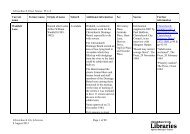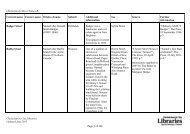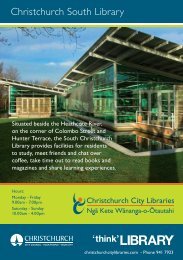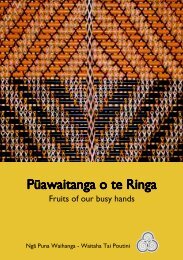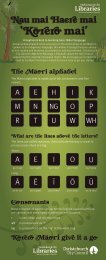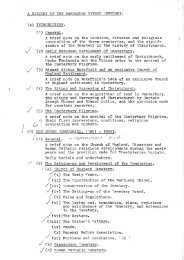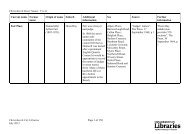Woolston / Heathcote Cemetery Tour - Christchurch City Libraries
Woolston / Heathcote Cemetery Tour - Christchurch City Libraries
Woolston / Heathcote Cemetery Tour - Christchurch City Libraries
Create successful ePaper yourself
Turn your PDF publications into a flip-book with our unique Google optimized e-Paper software.
were ‘filled with tubercles’. When the skull was opened the brain was shown to be<br />
very much thickened.<br />
Matilda Elizabeth Fry, 13, died but a month after her mother and was buried on 24<br />
December 1878.<br />
On 12 April 1880 at the manse of St. Andrew’s Presbyterian church, <strong>Christchurch</strong>, the<br />
Rev. Charles Fraser officiated at the wedding of John Fry, 37, widower, farmer, and<br />
Christina McLaren, 32, spinster.<br />
At Sydenham <strong>Cemetery</strong> there is the gravestone of Christina Fry who died, at 65, on<br />
29 September 1913. She was the widow of John Fry of Hanmer. Dorothy Jean,<br />
daughter of J. and F. Fry and granddaughter of John and Christina, died, aged five<br />
years, on 18 February 1921.<br />
Elsewhere at Sydenham Dorothy Jean’s parents are buried. Florence Jean Fry, 43,<br />
died on 14 October 1923 and John Douglas Fry, 83, died on 14 August 1966.<br />
Row K<br />
No. 450<br />
Charlesworth<br />
The name ‘Charlsworth’ or ‘Charlesworth’ means ‘the fortified holding of the<br />
churls or farmers’. It originated when the labouring Anglo-Saxons endeavoured to<br />
protect themselves against marauding Vikings.<br />
The son of Mary and William Charlesworth, William Charlesworth was born at<br />
Wistow, Yorkshire, on 3 May 1814. The older William was overseer to Edward<br />
Appleyard who owned the 135 acre farm ‘Garmancarr’ near Wistow. In 1829-30<br />
William junior went to sea, becoming first mate to an Australian, Robert Towns,<br />
captain and owner of The Brothers, and trading throughout the Pacific and Orient.<br />
Charlesworth captained another Towns vessel, the Royal Saxon, which travelled<br />
from Australia to England, India and Russia. Rice from China and sandalwood from<br />
India were included in the cargo, while people who boarded the ship included<br />
European immigrants and Chinese coolies who would work in the goldfields.<br />
In the mid ‘50s Charlesworth arrived at the steam wharf on the <strong>Heathcote</strong> River. He<br />
bought land and had mortgages over other properties, including the Mitre, Canterbury<br />
and Lyttelton Arms hotels in Lyttelton. He bought and leased land on Canal Reserve<br />
(Linwood Avenue) and thus was named Charlesworth Street. The captain’s main<br />
property, ‘Saxon Farm’, included ‘Saxon Villa’. The property consisted of<br />
… a capital brick built dwelling house on Ferry Road …complete in every<br />
particular. The house is built entirely of English material expressly imported<br />
by Captain Charlesworth. It contains 14 rooms, large dining and drawing<br />
rooms, breakfast room, bathroom, capital kitchen filled with every requisite,<br />
pantry, store room and all other conveniences …. The outbuildings consist of<br />
first class stabling, coal house, fowl house and piggeries and a garden covering<br />
<strong>Woolston</strong> / <strong>Heathcote</strong> <strong>Cemetery</strong><br />
2006<br />
39


